- Time of past OR future Camino
- First: Camino Francés 2002; most recent: Norte/Primitivo 2019
Years ago, I remember staring at a map of the different Caminos. OK, that part is hardly unusual, even today. But at that time I was focused on the blank space on the northern coast between Ribadeo, where the Camino del Norte veers inland, and Ferrol, where the Camino Inglés begins. Wouldn’t it be cool, I thought, if you could actually stay on the coast, all the way to Ferrol?
Well, you can actually stay on the coast, and it is, in fact, very cool. The route is called the Camino del Mar, aka the Camiño do Mar, aka the Ruta do Mar. I just completed my third trip on the Mar, both to enjoy it and to make a fresh round of guidebook updates, and I’m more excited about it than ever. Read on to learn more.
Is the Mar an official Camino?
That’s a more complicated question than you might initially appreciate! There is historical legitimacy to the route. We have records and physical remains of pilgrims walking through these towns. The cathedral, more recently, acknowledged the Mar. (For me, this triggered a shift in nomenclature, from “Ruta” to “Camino.”) I’ve seen pilgrims with distance certificates that include the Camino del Mar, so that speaks to the acknowledgement. However, the Xunta has not *yet* recognized the Mar, though it will rule on this soon. That formal recognition would bring funding, which would be very helpful! But I have no qualms about labeling this as a “real” branch of the Camino.
Does the Mar have a significant spiritual element?
Yes, absolutely. First, the Mar brings pilgrims to the oldest cathedral in all of Spain: San Martiño de Mondoñedo. Likely originating in the 9th century, and no longer functioning as an official cathedral, the basilica preserves some of its original murals. The adjacent botanical gardens are a nice bonus.
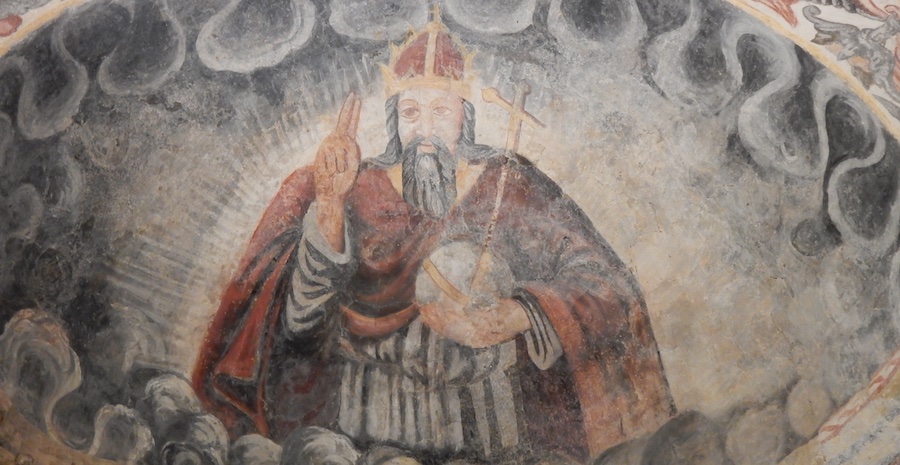
More significant, though, is the village of San Andrés de Teixido, arguably the second most significant pilgrimage site in Galicia. James, it turns out, wasn’t the only apostle to end up in the northwest corner of Spain! Saint Andrew, the story goes, was stranded by the cliffs neighboring Teixido after his boat capsized. After settling here, the poor guy grew envious of the pilgrim traffic to Santiago, and fair enough. He complained to God and Saint Peter; in turn, he was promised that all mortals would come to his sanctuary, living or dead. By one account, those who don’t make it on their first go-round will be reincarnated as lizards to make the journey. So you’re coming to Teixido one way or another–might as well do it the fun way, on pilgrimage!
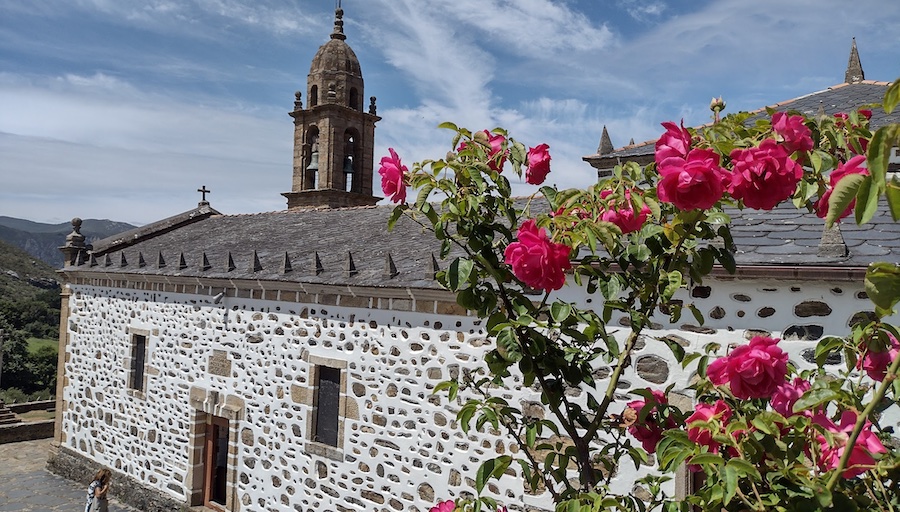
Teixido is a fabulous little village, perched high above the Atlantic. It’s an amazing place to see the sun set. The little church has a colorful altar, lined with offerings in support of intercessory prayer. The few bars in the village specialize in percebes, or “goose barnicles,” which I heard multiple pilgrims rave about.
How is the waymarking?
I’m glad you asked, because this is the most exciting development over the past few years. First, though, it’s important to lay out some definitions related to what we’re talking about when we talk about the Camino del Mar…
If you’ve walked the Camino del Norte, you know that there are multiple sections where the yellow arrows lead inland. However, the GR E9, a walking route marked with red and white blazes, roughly parallels the Norte, sometimes overlapping, and sometimes taking a more scenic (often longer) approach closer to the coast. So, pilgrims on the Norte will periodically opt to deviate from the “official” Norte and follow the GR instead.
Similarly, on the Mar you have the “official” Camino del Mar, which often will veer inland for a shorter approach that tends to link together different churches in small villages, while other coastal options provide interesting alternatives. So, with that in mind, back to the waymarking question. It varies!
The “official” Camino del Mar has vastly improved yellow arrows that pick up after Rinlo (a small town after Ribadeo) and are fairly reliable en route to Teixido. They’re not perfect. Cities are very tricky. Some wooded stretches are difficult, as plant overgrowth or peeling eucalyptus trees can obscure the markings. But they are so, so much better than they were just a few years ago, and local Amigos are to be praised for their dedication to this work. It has made a huge difference.
As Teixido is a significant pilgrimage site, it also has its own waymarks, which include slim cement Ichthys posts. These pick up on the Mar as you get closer to Teixido, but they are much more prominent between Teixido and Narón, on the Camino Inglés. If you choose to follow the direct, inland, “official” Camino del Mar between Teixido and Narón, you’ll mostly be relying on the Teixido arrows and posts, and they’re quite reliable. Note that if you do this, you will also bypass the center of Ferrol!
Between Ribadeo and Ladrido (just after O Porto de Espasante), the “Camiño Natural da Ruta do Cantábrico” (I’m just going to call it the Cantábrico) generally follows the coast and is exceptionally well waymarked. Leaving Ribadeo, the Mar follows the Cantábrico for the opening ~20km, and they overlap at plenty of other points.
After the Cantábrico ends, things get more complicated on the coast. Some parts of the route are unmarked. Some, including a few unfortunate stretches, are highway bound for a while. At other points, though, it links together other established, lovely routes. For example, the coastal walk from Teixido to Cedeira is magnificent walking with clear arrows on the “Ruta dos Peiraos,” and further south, after Lavacerido, the “Costa Ártabra” is similarly well marked and amazingly scenic.
In sum, I would still advise any pilgrim walking the Mar to do so with gps tracks. You’ll be able to walk long stretches by solely following the waymarks, but you’ll be happy to have them for tricky intersections, towns, and some of the unmarked variants. I’m optimistic, though, that this will continue to improve as more pilgrims discover the Mar–and especially if the Xunta comes through.
Is there a pilgrim infrastructure?
Beyond waymarks, I’ll define infrastructure here as accommodation, water, services, baggage transport, and stamps/sellos.
There is only one albergue on the Mar currently, the Oli Vita Hostel in Viveiro. It’s not an “albergue de peregrinos,” but it’s very pilgrim-friendly, and its host, Oliva, is a huge advocate of the Mar. Having only one albergue is obviously not ideal.
On the bright side, many parts of the Mar are well off the beaten path, and most holiday-goers looking for a beach vacation don’t make it to this area. As such, even in summer there are some towns with very budget-friendly hotels. Burela, O Vicedo, and O Porto de Espasante, especially, had rooms in the 30-40 euro range when I passed through during the peak of this summer.
That said, there are some stretches where the only accommodation options are pricier, and this is particularly true for pilgrims who want/need to walk shorter stages. (The exciting news is that there is now a casa rural in San Andrés de Teixido, as it didn’t have any accommodation options for years. It’s also gorgeous, with a price to match.)
As such, budget-conscious pilgrims currently have two options. One is to wild camp. That’s easy to do on many parts of the Mar, but I recognize it’s a non-starter for most pilgrims. The other is to do the FEVE shuffle. The FEVE train line roughly parallels the Mar between Ribadeo and A Ponte de Mera, so some pilgrims will set up shop in one town for a few nights, then use the train to pop back and forth. The train is no longer an option after A Ponte de Mera, but there are buses linking together some of the other towns.
Water access varies by location. Between Ribadeo and Covas, you’re unlikely to go much more than 10km without a refill point, between the fountains and bars along the way. After that, though, you might face some longer stretches, especially between Covas and Esteiro, and again from A Ponte de Mera en route to Teixido. So it’s not perfect, but you can always knock on a door, put on a smile, and make a friend.
I generally have no trouble getting my daily coffees, resupplying on groceries, or finding a restaurant when I need one, but some anticipation is required. That is to say, as with water, there are some occasional longer stretches (in the 20-25km range) where you won’t find an open bar, but you’ll generally have access to a supermarket or grocery prior to those, so you can stock up accordingly.
There is no baggage transport on the Mar right now, and I doubt it’s coming in the near-term. There just isn’t enough traffic to justify it. The FEVE shuffle is probably a solution for this as well, though–establish a base camp, leave your pack, and walk freely.
Finally, stamps are hit-or-miss. Some accommodations have already embraced this and have the aesthetically-pleasing stamps that we love on Camino. Ayuntamientos have town stamps, if you can catch them open. But every business in Spain is going to have an address stamp, and that’ll do the job if you want something in your credential.
Are there interesting or beautiful things to see?
Oh my goodness, yes. Beyond the pilgrimage-specific sites mentioned above, the Mar is overstuffed with incredible scenery. I’m going to forcibly limit myself to ten:
1) Praia das Catedrais (Stage 1): It’s in the running for the most famous beach in Spain. Do everything you can to hit it at low tide (keeping in mind that you have to make a reservation). I haven’t had the good fortune yet, but even at moderate tide it’s gorgeous.
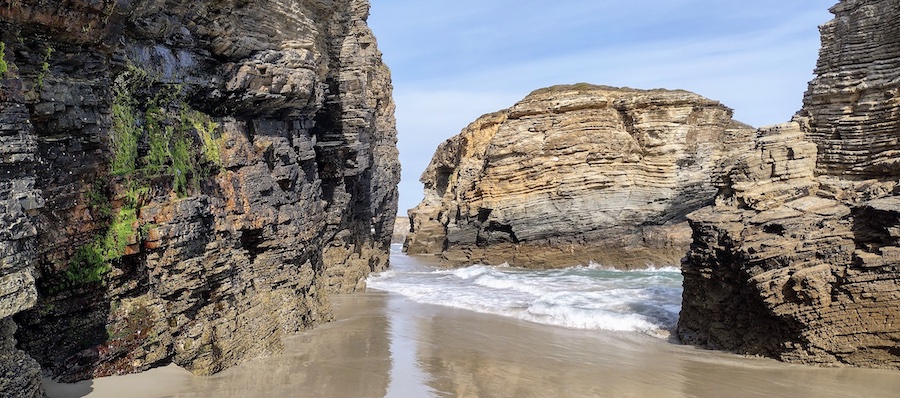
2) The Sargadelos ruins (Stage 3): Maybe you’ve seen the lovely white and blue porcelain pieces for sale at shops around Galicia and beyond. They’re iconic. Well, Sargadelos has a long history, and it originated here, in these evocative ruins.
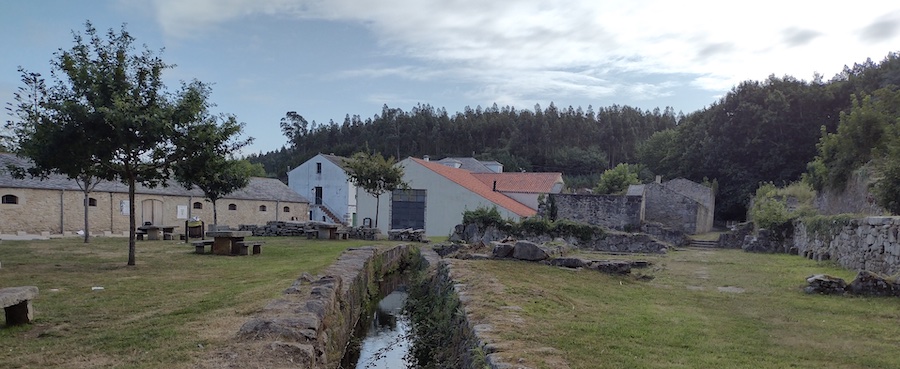
3) San Cibrao (Stage 3): A delightful beach town organized around a perfect little peninsula, with a legendary association with mermaids.
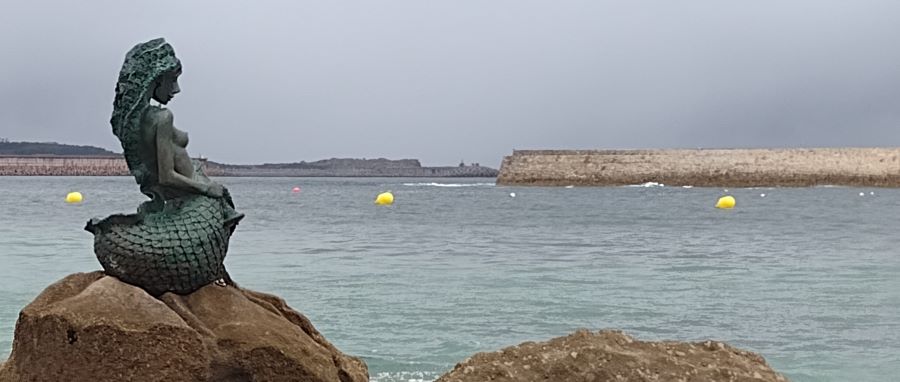
4) Viveiro (Stage 4): For my money, the most interesting town on the Mar. A picture-perfect old town, distinguished by the region’s characteristic “galerias” lining each building.
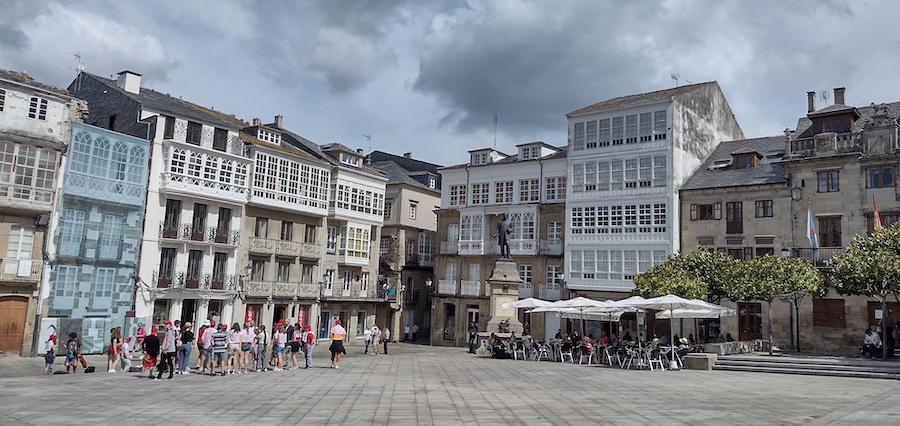
5) El Mejor Banco Del Mundo (Stage 5): While “the best bench in the world” gets the headlines, the coastal walk from Playa de Esteiro to O Porto de Espasante is marvelous, nearly every step of the way
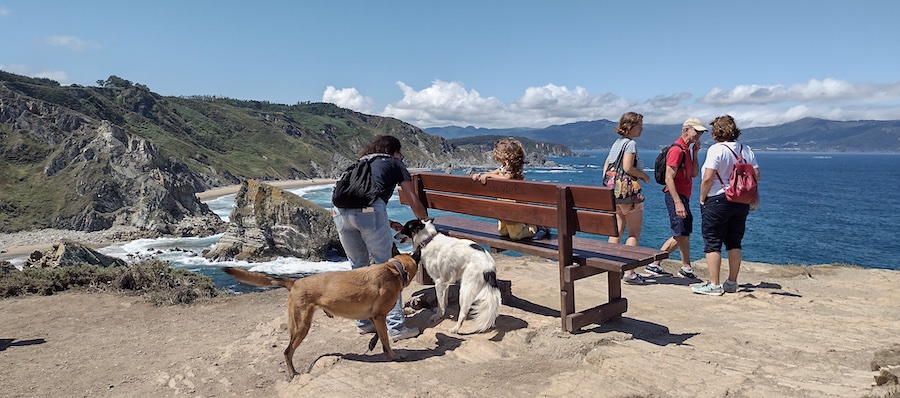
6) The Castelo de Casón (Stage 6): The ruins that survive are very limited, but the views from the top are fantastic
7) Miradoiro de Garita de Herbeira (Stage 6): The views from the cliffs surrounding Teixido are amazing, but this viewpoint stands out as especially memorable (and not just because, after seeing zero pilgrims my whole walk, I miraculously found two separate pilgrims here!)
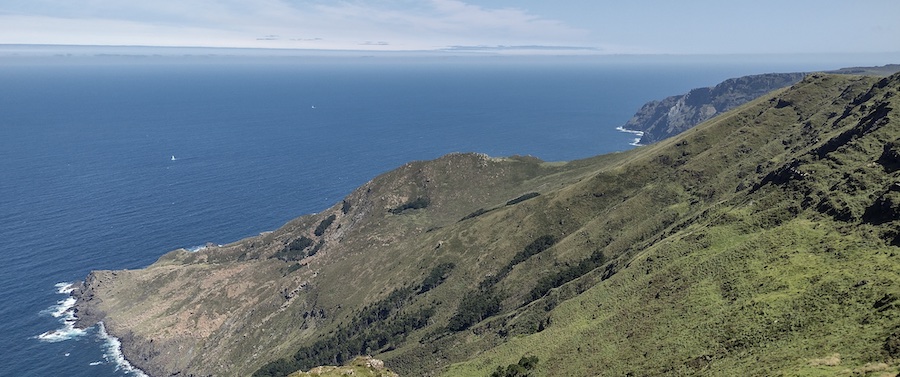
8) The Praia Da Frouxeira in Valdoviño (Stage 7): This very popular surf town has a huge beach that you can walk across, proceeding alongside the interior lagoon
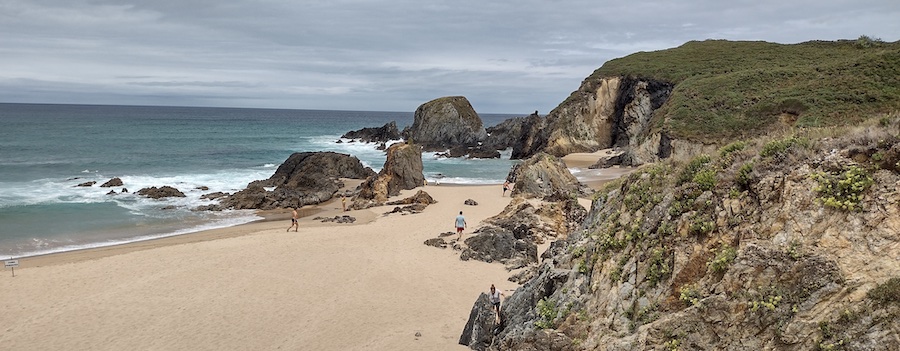
9) The Costa Ártabra trail after Lavacerido (Stage 7): Another exceptional stretch of coastal walking
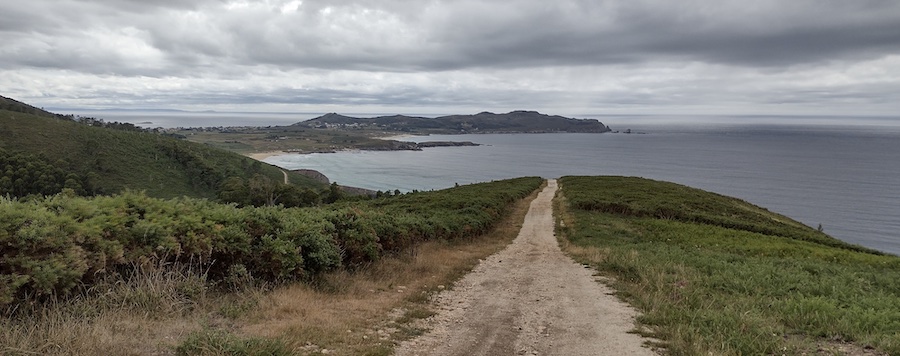
10) Castelo de San Filipe (Stage 7): For those following the coast, your final approach to Ferrol begins with this hulking castle
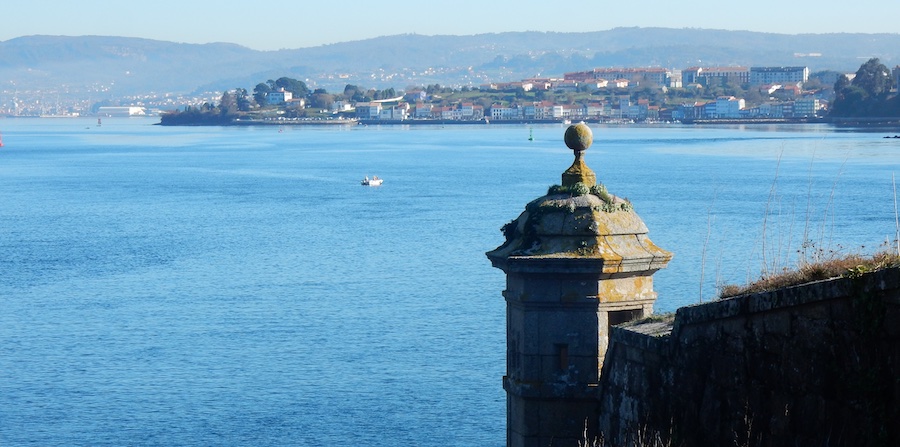
This has gone long enough, so to sum it up…
The Camino del Mar isn’t for everyone. The lack of albergues and luggage transport, combined with the need for gps will turn many away. But if you want stunning natural beauty, solitude, and enough interesting and significant historical/cultural sites to sate your curiosity, then I recommend it enthusiastically!
Well, you can actually stay on the coast, and it is, in fact, very cool. The route is called the Camino del Mar, aka the Camiño do Mar, aka the Ruta do Mar. I just completed my third trip on the Mar, both to enjoy it and to make a fresh round of guidebook updates, and I’m more excited about it than ever. Read on to learn more.
Is the Mar an official Camino?
That’s a more complicated question than you might initially appreciate! There is historical legitimacy to the route. We have records and physical remains of pilgrims walking through these towns. The cathedral, more recently, acknowledged the Mar. (For me, this triggered a shift in nomenclature, from “Ruta” to “Camino.”) I’ve seen pilgrims with distance certificates that include the Camino del Mar, so that speaks to the acknowledgement. However, the Xunta has not *yet* recognized the Mar, though it will rule on this soon. That formal recognition would bring funding, which would be very helpful! But I have no qualms about labeling this as a “real” branch of the Camino.
Does the Mar have a significant spiritual element?
Yes, absolutely. First, the Mar brings pilgrims to the oldest cathedral in all of Spain: San Martiño de Mondoñedo. Likely originating in the 9th century, and no longer functioning as an official cathedral, the basilica preserves some of its original murals. The adjacent botanical gardens are a nice bonus.

More significant, though, is the village of San Andrés de Teixido, arguably the second most significant pilgrimage site in Galicia. James, it turns out, wasn’t the only apostle to end up in the northwest corner of Spain! Saint Andrew, the story goes, was stranded by the cliffs neighboring Teixido after his boat capsized. After settling here, the poor guy grew envious of the pilgrim traffic to Santiago, and fair enough. He complained to God and Saint Peter; in turn, he was promised that all mortals would come to his sanctuary, living or dead. By one account, those who don’t make it on their first go-round will be reincarnated as lizards to make the journey. So you’re coming to Teixido one way or another–might as well do it the fun way, on pilgrimage!

Teixido is a fabulous little village, perched high above the Atlantic. It’s an amazing place to see the sun set. The little church has a colorful altar, lined with offerings in support of intercessory prayer. The few bars in the village specialize in percebes, or “goose barnicles,” which I heard multiple pilgrims rave about.
How is the waymarking?
I’m glad you asked, because this is the most exciting development over the past few years. First, though, it’s important to lay out some definitions related to what we’re talking about when we talk about the Camino del Mar…
If you’ve walked the Camino del Norte, you know that there are multiple sections where the yellow arrows lead inland. However, the GR E9, a walking route marked with red and white blazes, roughly parallels the Norte, sometimes overlapping, and sometimes taking a more scenic (often longer) approach closer to the coast. So, pilgrims on the Norte will periodically opt to deviate from the “official” Norte and follow the GR instead.
Similarly, on the Mar you have the “official” Camino del Mar, which often will veer inland for a shorter approach that tends to link together different churches in small villages, while other coastal options provide interesting alternatives. So, with that in mind, back to the waymarking question. It varies!
The “official” Camino del Mar has vastly improved yellow arrows that pick up after Rinlo (a small town after Ribadeo) and are fairly reliable en route to Teixido. They’re not perfect. Cities are very tricky. Some wooded stretches are difficult, as plant overgrowth or peeling eucalyptus trees can obscure the markings. But they are so, so much better than they were just a few years ago, and local Amigos are to be praised for their dedication to this work. It has made a huge difference.
As Teixido is a significant pilgrimage site, it also has its own waymarks, which include slim cement Ichthys posts. These pick up on the Mar as you get closer to Teixido, but they are much more prominent between Teixido and Narón, on the Camino Inglés. If you choose to follow the direct, inland, “official” Camino del Mar between Teixido and Narón, you’ll mostly be relying on the Teixido arrows and posts, and they’re quite reliable. Note that if you do this, you will also bypass the center of Ferrol!
Between Ribadeo and Ladrido (just after O Porto de Espasante), the “Camiño Natural da Ruta do Cantábrico” (I’m just going to call it the Cantábrico) generally follows the coast and is exceptionally well waymarked. Leaving Ribadeo, the Mar follows the Cantábrico for the opening ~20km, and they overlap at plenty of other points.
After the Cantábrico ends, things get more complicated on the coast. Some parts of the route are unmarked. Some, including a few unfortunate stretches, are highway bound for a while. At other points, though, it links together other established, lovely routes. For example, the coastal walk from Teixido to Cedeira is magnificent walking with clear arrows on the “Ruta dos Peiraos,” and further south, after Lavacerido, the “Costa Ártabra” is similarly well marked and amazingly scenic.
In sum, I would still advise any pilgrim walking the Mar to do so with gps tracks. You’ll be able to walk long stretches by solely following the waymarks, but you’ll be happy to have them for tricky intersections, towns, and some of the unmarked variants. I’m optimistic, though, that this will continue to improve as more pilgrims discover the Mar–and especially if the Xunta comes through.
Is there a pilgrim infrastructure?
Beyond waymarks, I’ll define infrastructure here as accommodation, water, services, baggage transport, and stamps/sellos.
There is only one albergue on the Mar currently, the Oli Vita Hostel in Viveiro. It’s not an “albergue de peregrinos,” but it’s very pilgrim-friendly, and its host, Oliva, is a huge advocate of the Mar. Having only one albergue is obviously not ideal.
On the bright side, many parts of the Mar are well off the beaten path, and most holiday-goers looking for a beach vacation don’t make it to this area. As such, even in summer there are some towns with very budget-friendly hotels. Burela, O Vicedo, and O Porto de Espasante, especially, had rooms in the 30-40 euro range when I passed through during the peak of this summer.
That said, there are some stretches where the only accommodation options are pricier, and this is particularly true for pilgrims who want/need to walk shorter stages. (The exciting news is that there is now a casa rural in San Andrés de Teixido, as it didn’t have any accommodation options for years. It’s also gorgeous, with a price to match.)
As such, budget-conscious pilgrims currently have two options. One is to wild camp. That’s easy to do on many parts of the Mar, but I recognize it’s a non-starter for most pilgrims. The other is to do the FEVE shuffle. The FEVE train line roughly parallels the Mar between Ribadeo and A Ponte de Mera, so some pilgrims will set up shop in one town for a few nights, then use the train to pop back and forth. The train is no longer an option after A Ponte de Mera, but there are buses linking together some of the other towns.
Water access varies by location. Between Ribadeo and Covas, you’re unlikely to go much more than 10km without a refill point, between the fountains and bars along the way. After that, though, you might face some longer stretches, especially between Covas and Esteiro, and again from A Ponte de Mera en route to Teixido. So it’s not perfect, but you can always knock on a door, put on a smile, and make a friend.
I generally have no trouble getting my daily coffees, resupplying on groceries, or finding a restaurant when I need one, but some anticipation is required. That is to say, as with water, there are some occasional longer stretches (in the 20-25km range) where you won’t find an open bar, but you’ll generally have access to a supermarket or grocery prior to those, so you can stock up accordingly.
There is no baggage transport on the Mar right now, and I doubt it’s coming in the near-term. There just isn’t enough traffic to justify it. The FEVE shuffle is probably a solution for this as well, though–establish a base camp, leave your pack, and walk freely.
Finally, stamps are hit-or-miss. Some accommodations have already embraced this and have the aesthetically-pleasing stamps that we love on Camino. Ayuntamientos have town stamps, if you can catch them open. But every business in Spain is going to have an address stamp, and that’ll do the job if you want something in your credential.
Are there interesting or beautiful things to see?
Oh my goodness, yes. Beyond the pilgrimage-specific sites mentioned above, the Mar is overstuffed with incredible scenery. I’m going to forcibly limit myself to ten:
1) Praia das Catedrais (Stage 1): It’s in the running for the most famous beach in Spain. Do everything you can to hit it at low tide (keeping in mind that you have to make a reservation). I haven’t had the good fortune yet, but even at moderate tide it’s gorgeous.

2) The Sargadelos ruins (Stage 3): Maybe you’ve seen the lovely white and blue porcelain pieces for sale at shops around Galicia and beyond. They’re iconic. Well, Sargadelos has a long history, and it originated here, in these evocative ruins.

3) San Cibrao (Stage 3): A delightful beach town organized around a perfect little peninsula, with a legendary association with mermaids.

4) Viveiro (Stage 4): For my money, the most interesting town on the Mar. A picture-perfect old town, distinguished by the region’s characteristic “galerias” lining each building.

5) El Mejor Banco Del Mundo (Stage 5): While “the best bench in the world” gets the headlines, the coastal walk from Playa de Esteiro to O Porto de Espasante is marvelous, nearly every step of the way

6) The Castelo de Casón (Stage 6): The ruins that survive are very limited, but the views from the top are fantastic
7) Miradoiro de Garita de Herbeira (Stage 6): The views from the cliffs surrounding Teixido are amazing, but this viewpoint stands out as especially memorable (and not just because, after seeing zero pilgrims my whole walk, I miraculously found two separate pilgrims here!)

8) The Praia Da Frouxeira in Valdoviño (Stage 7): This very popular surf town has a huge beach that you can walk across, proceeding alongside the interior lagoon

9) The Costa Ártabra trail after Lavacerido (Stage 7): Another exceptional stretch of coastal walking

10) Castelo de San Filipe (Stage 7): For those following the coast, your final approach to Ferrol begins with this hulking castle

This has gone long enough, so to sum it up…
The Camino del Mar isn’t for everyone. The lack of albergues and luggage transport, combined with the need for gps will turn many away. But if you want stunning natural beauty, solitude, and enough interesting and significant historical/cultural sites to sate your curiosity, then I recommend it enthusiastically!














